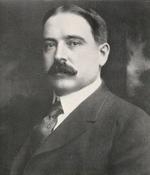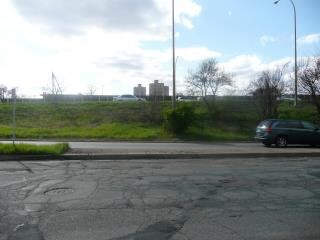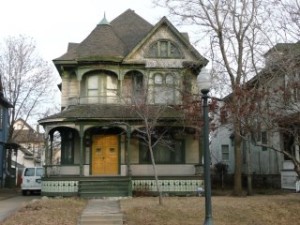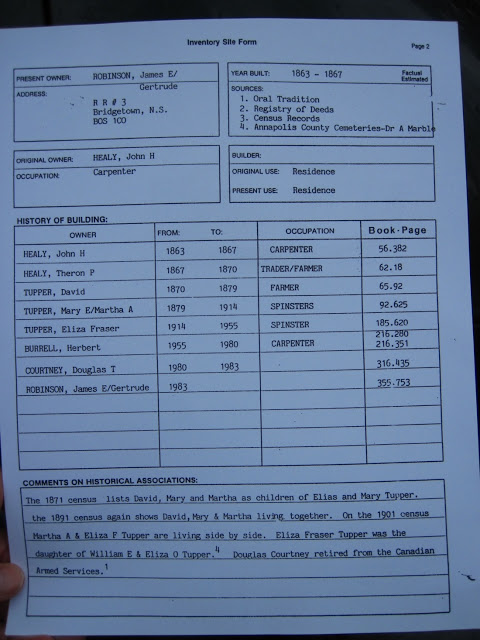
Welcome to the
Healy Project
Join us on Facebook
Send us an Email
On Memorial Day
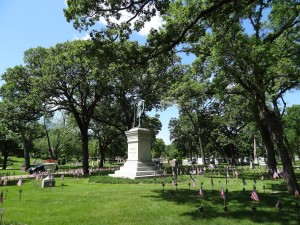 |
| The Civil War monument at Lakewood Cemetery, where the memorial service, with a speech by Gov. Dayton, was held today. |
Years ago, my family would go to Lakewood on Memorial Day to place flowers from the garden on the graves of family members who once lived in our house. We had no relatives’ graves to visit in Minneapolis, so we adopted the Beardsleys, if only for a day. As we learned more about local master builders through researching the history of houses in the neighborhood, we added to our Lakewood visits a trip to the grave sites of the three most prominent of them: T.P. Healy, Henry Ingham, and Henry Parsons. (When we eventually found and contacted the descendants of Ingham, his granddaughter remarked, “So you’re the ones who have been putting flowers on Granddad’s grave!”)
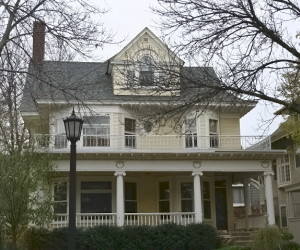 |
| 1712 Dupont Avenue South: An 1897 Healy house whose exterior hasn’t changed much over the last century. |
 |
| The marker, with caterpillar and feather. |
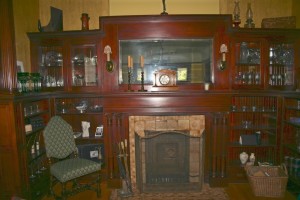 |
| The fireplace nook in a beautifully preserved 1894 Healy Queen Anne. |
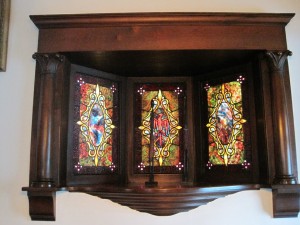 |
| The stained glass windows on the staircase landing of an 1899 Healy house. |
 |
| The original tiled floor in the vestibule of another 1899 Healy. |
On Memorial Day we thank T.P. Healy, Henry Ingham, Henry Parsons, Nels Jenson, C.C. Johnson, and the other master builders and architects who created the old houses that we live in or pass by every day on the streets of Minneapolis.
Let me conclude with my favorite quote about builders and their buildings from the “Lamp of Memory” section (appropriate for Memorial Day) of John Ruskin’s 1849 work, The Seven Lamps of Architecture:
When we build, let us think that we build forever.
Let it not be for present delight nor for present use
alone. Let it be such work as our descendants will
thank us for; and let us think, as we lay stone on
stone, that a time is to come when those stones
will be held sacred because our hands have
touched them, and that men will say, as they look
upon the labor and wrought substance of them,
“See! This our fathers did for us.”
I think Healy and the others could relate to that.
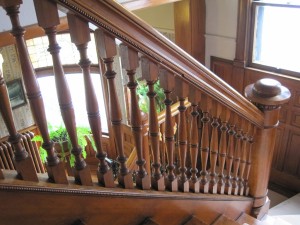 |
| Staircase spindles in an 1895 Healy. |
–T.B.
Note: This is a corrected version of the May 23rd posting, edited after a recent interview with Wayne Tinberg. A new post on that interview will follow.
 |
| The roadbed for 35W being laid in Richfield in 1960. |
The previous blog post was devoted to three Healy houses lost to freeway construction and one to changes in fashion. So far, the entries on this blog have presented the building list of Healy houses in roughly chronological order.
At this point, it may be helpful to take a look specifically at all the houses wrecked for I-35W construction in 1959-60, no matter what their building date.
According to city records, nine houses designed by T.P. Healy were built on the west side of the 3100 block of Second Ave. South. In order of house number, they are:
3106, built in 1888 for $3,000
3108, built in 1888 for $3,000
3142, built in 1887 for $4,000
1896–3116
 |
| An old photo of 3130 Second Avenue (courtesy Robert-Jan Quene). It would be interesting to find more photos of these lost Healy houses. |
The most famous resident of that block was Richard W. Sears, co-founder of the Sears and Roebuck Company.
–T.B.
3132 Second Ave. So.
40 x 52 Frame dwelling
Owner: T. P. Healy
Architect:
Builder:
B19302
6-22-89 / 10-1-89
Est. cost: $5,000.
This house is much wider than he is typically building at this time. By starting this house, we can see from the dates on the permits that he is working on three different houses in two different neighborhoods–Central and Kenwood.
3130 Second Ave. So.
30 x 52 Frame dwelling
Owner: T. P. Healy
Architect:
Builder:
B18375
4-17-89 / 8-1-89
Est. cost: $5,000.
3136 Second Ave. So.
35 x 60 Stone ven. dwelling
Owner: T. P. Healy
Architect:
Builder: T. P. Healy
B25946
8-5-91 / 11-1-91
Est. cost: $7,000.
Wrecked: 1960
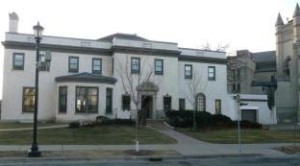 |
| 425 Groveland Avenue |
Permit information:
425 Groveland Ave.
82.9 x 56.7 Tile Dwelling
Owner: Gilbert M. Walker
Architect: Ernest Kennedy
Builder: Nels Jenson
B173713
10-3-23 / 5-1-24
(Interior to be completed later.)
Est. cost: $30,000.
Gilbert Walker would die in 1928; his wife lived until 1951.
From Wikipedia: The (Walker) Museum’s focus on modern art began in the 1940’s , when a gift from Mrs. Gilbert Walker made possible the acquisition of works by important artists of the day including sculptures by Picasso, Henry Moore, Alberto Giacometti and others.
T. P. Healy had built a house for J. B. Gilfillan at 218 Clifton Ave. in 1905-06, designed by the same architect, Ernest Kennedy.
Nels Jenson, the builder of this house, was Healy’s foreman.–A.C.
3111 Second Ave. So.
Owner: T. P. Healy
Architect:
Builder:
B25565
6-10-91 / 9-1-91
Est. cost: $5,000.
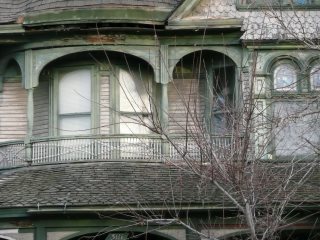 |
| The second floor porch below the tower, the front of the house curved, the balcony railing curved, unique among existing Healy houses. |
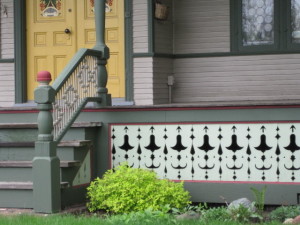 |
|
| Detail of front porch, with the classic double entry doors. For everyone who has been here, this is the spiritual center of the Healy Block. |
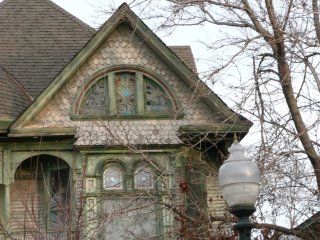 |
|
| The front gable end with half-round window and fishscale shakes. |
-A.C.
Bev Wigney, a native of eastern Ontario, is doing some checking into Healy’s life and work there. She is the owner of a house that had been built by T.P.’s brother, John H. Healy. She reports:
“Now that I am back in Round Hill, I went through some of my papers and found this survey page on a house that lists Theron Healy as owner from 1867 to 1870. Interesting is that the previous property owner was John H. Healy, who was the owner-builder of my old place here at Round Hill. I will post a link to the reverse side of this page which lists the history of ownership. Unfortunately, this house has been radically altered and I would not have recognized it but for my neighbour next door knowing the house as soon as he saw the photo and I asked him about the last owner.”
 |
| The document with image of Healy’s first family home, dated 1996. The original house was undoubtedly a simple Greek Revival design. |
Theron and Mary Anne were married in 1866. He was 22; she 19. Their first two children, Lena (1867) and Alice Edna (architect John Cuningham’s grandmother, 1868) were born in Round Hill. By 1870 they apparently had moved to Annapolis, NS, where their first son, Charles, was born.
John Cuningham on a recent trip to Nova Scotia discovered that T. P. Healy owned ships moving hardware up and down the New England/Maritime Canadian Coast. Did his hardware business grow out of the Round Hill Woodworks?
Theron Potter Healy was born in Round Hill, Nova Scotia, Canada, on May 14th, 1844. In 1866 he married Mary Anne Jefferson, also of Round Hill. From what we can piece together, Healy started his career as a shipbuilder. He moved to Halifax, where he continued in the shipbuilding trade. However, disaster struck in 1883, when one of the vessels he owned was lost in a storm. Because of this loss, and probably also because wooden ships were at the end of their commercial use, Healy picked up his growing family and moved to Minneapolis. Three years later his first house went up at 3137 Second Avenue South.
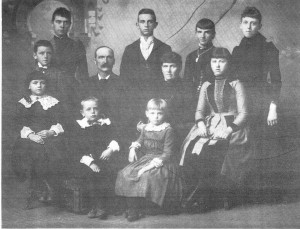 |
| Theron and Mary Ann with their children. l-r back row: Alice, Charles, Dora, Lena; middle row: Reginald, T.P.,Mary Anne, Erena; front row: Birdie, Chester, Bessie. |
(Thanks to the Halifax (NS) Public Library, info on the shipwreck that spurred T.P.’s move to the US–Vessel: Mary E. Banks, Type: Schooner (wood, 2 masts, 1 deck), Tonnage: 50.2, Length: 62.4′, Breadth: 17.6, Draft: 8′, Built at Barrington, NS, 1863, Date lost: August 30, 1883, Cause: Stranded during gale on shoals off L’Ardoise, Cape Breton, Value: vessel $1,500+ cargo $2,000, Owner: Theron Healy.)
Much research remains to be done on Healy’s work in Canada. Round Hill is a small community on the Annapolis River, off the Bay of Fundy on Nova Scotia’s west coast. Here are images from Round Hill currently on the Web:
 |
| This vernacular Gothic Revival house in rural Round Hill is listed for sale at $198,.000. No building date is given, but its style suggests it was built mid-19th century. Shown at right is its barn with the gambrel roof Healy used so frequently in his later designs. |
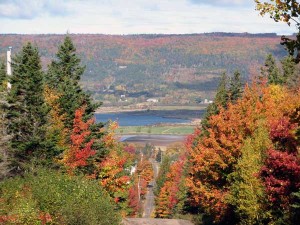 |
| The Annapolis Valley from Round Hill in autumn. |
–T.B.
Permit information:
3120 Third Ave. So.
Owner: T. P. Healy
Architect:
Builder:
B24031
11-4-90 / 5-1-91
Est. cost: $6,000.
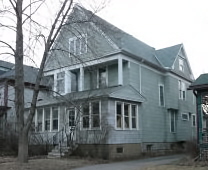 |
| The significance of this house is told by the building dates. Healy begins to build a house in the winter. Now how difficult would that have been in 1891? |
Although the house has been clad in asbestos shakes sometime mid-20th century, according to Mina Blyly-Strauss, who grew up in the house, it’s “not so pretty on the outside, but has all the stained glass and natural woodwork throughout. The second floor layout matches 3116 Third and the first floor is similar. including a very similar entry staircase in the front, though–unlike 3116– the third floor is unfinished. It was duplexed at one time, but the only thing left of the second floor kitchen are the sink and some upper cabinets.“
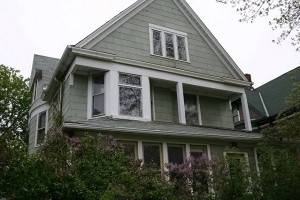 |
| Underneath the siding and porch enclosure, one can still see remnants of the original Healy exterior in the second-floor bay window and balcony, the rounded section under the side gable, and the high front gable end. |
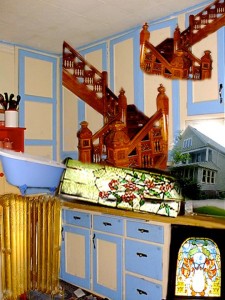 |
| A collage of images of 3120 from the Healy Block 1998 photo series (photo courtesy Mina Blyly-Strauss) |
–A.C.
Permit information:
3101 Second Ave. So.
30 x 60 Wood dwelling
Owner: T. P. Healy
Architect:
Builder:
B23331
8-23-90 / 11-1-90
$6,000.
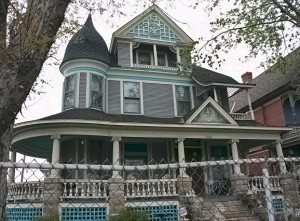 |
| Originally the residence of Dr. Rufus H. Lane, this Queen Anne is one of the most visible Healys, well known by people exiting 35W at 31st Street. |
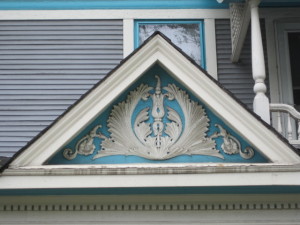 |
| Detail over the porch entrance |
The entrance has classic double solid doors. The classical porch columns, dentils, and this appliqué decoration look like a very early attempt to neo-classicise a Queen Anne. Healy built a house on the southern corner of this block the previous year. He seems determined here to show us everything he’s got.
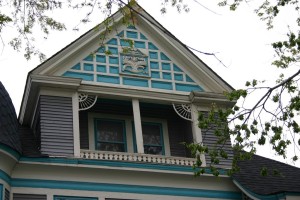 |
| The third floor enclosed porch, with detailing above echoing design above entrance. The paneled gable end is similar to that of 2936 Portland, built the same year. |
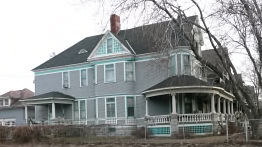 |
| Back porch on the side, eyebrow dormer curved bay under northside gable end (probably with both curved glass window sash and curved glass storms, curved wraparound front porch, corner tower with a bell roof, and that is just the north side.The trees in front protect this house from the western sun in the summer and help absorb the noise of 35W. |
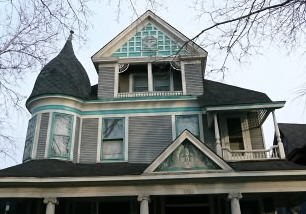 |
| Third floor porch below paneled gable end, the corner tower with the bell roof, and the second floor porch with the cat-slide roof. |
2936 Portland Ave. So.
28 x 60 Frame dwelling
Owner: T. P. Healy
Architect:
Builder: T. P. Healy
B22718
6-12-90 / 9-1-90
Est. cost: $6,000.
I have been scrupulous in recording how Healy fills out the building permit in regards the lines Owner, Architect, and Builder. I have no idea why he chooses to put himself down as the builder on this house when he typically does not.
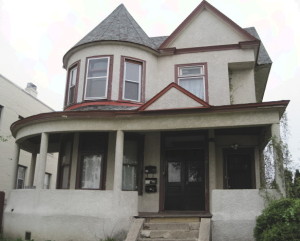 |
| So much of the design aesthetic of this period is integrating the round and curves with the rectilinear and the triangle. Healy gives us dozens of variations with very few identical twins. (Photo from May 2011) |
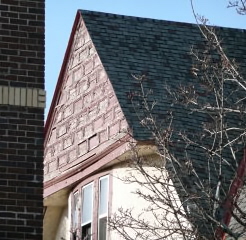 |
| The southside gable end. Note the characteristic Healy curved second story wall below the gable end. |
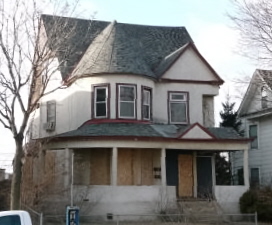 |
| By the end of 2011, the house was vacant and boarded up. In 1981 the then-owners of this house told the researchers that it had a ghost cat who would run down the stairs from the upper unit and leap through the closed door. –A.C. |
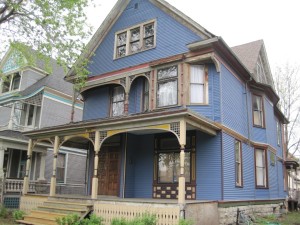 |
| A relatively plain Healy Queen Anne set between its more elaborate neighbors. According to Madeline Douglas, the current owners, the Mauris, have brought this house back to life. Master Carpenter Peter Holly, who lives on the Healy Block, has restored the porch woodwork to its intricate original glory, as he has so many other Healys. |
Permit information:
3107 Second Ave. So.
30 x 50 Frame dwelling
Owner: T. P. Healy
Architect:
Builder:
B24747
3-30-91 / 6-1-91
Est. cost: $5,000.
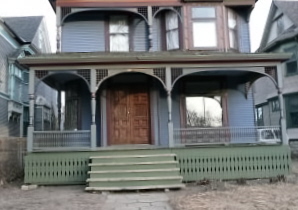 |
| This photo shows the porch restoration by Peter Holly. The porch and entrance reveal the elegance of Healy’s design: the delicacy of the posts, railings, and upper trim, the classic double entrance doors, the skirting, the curved window, the elaborately trimmed main window. |
